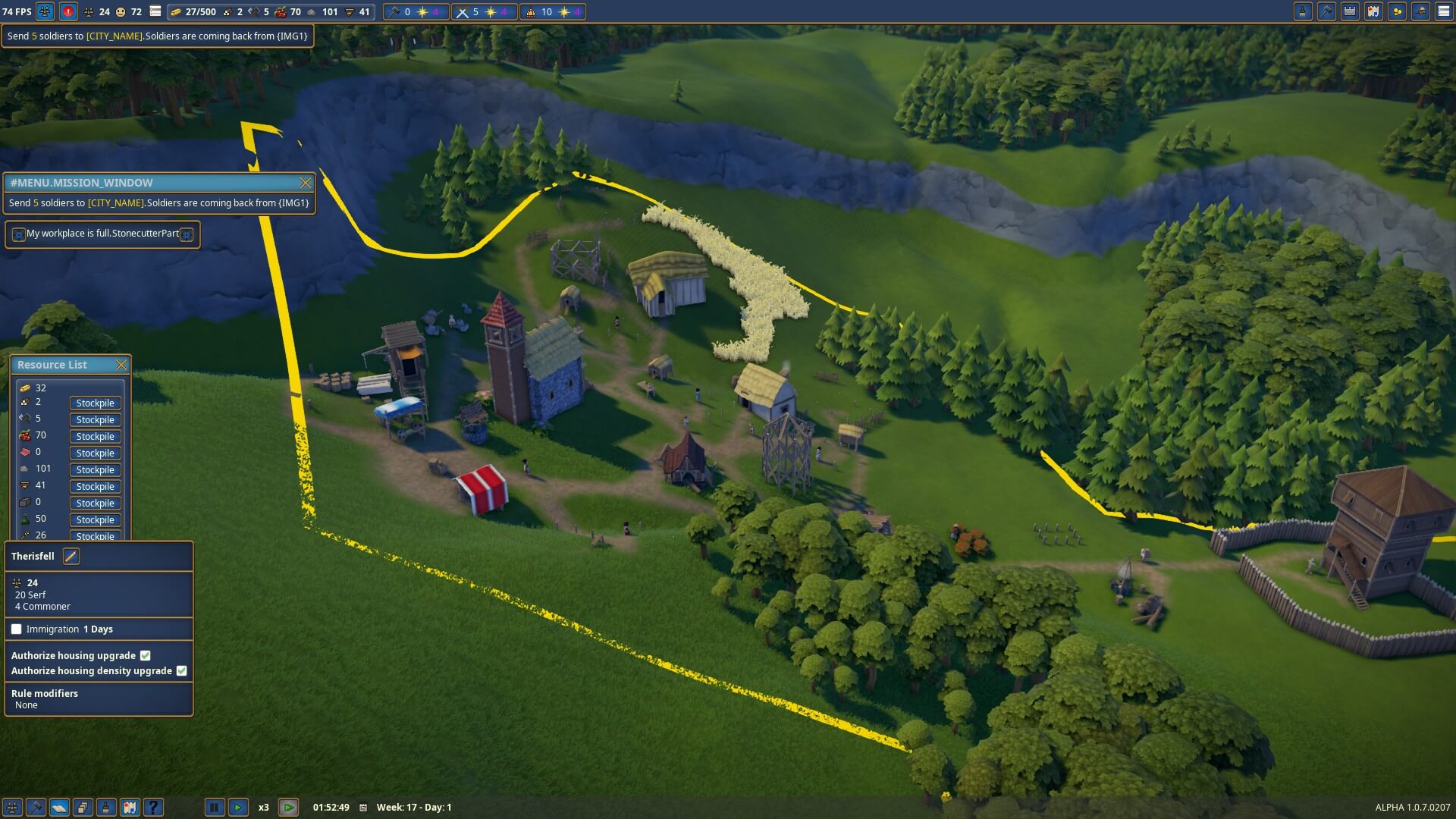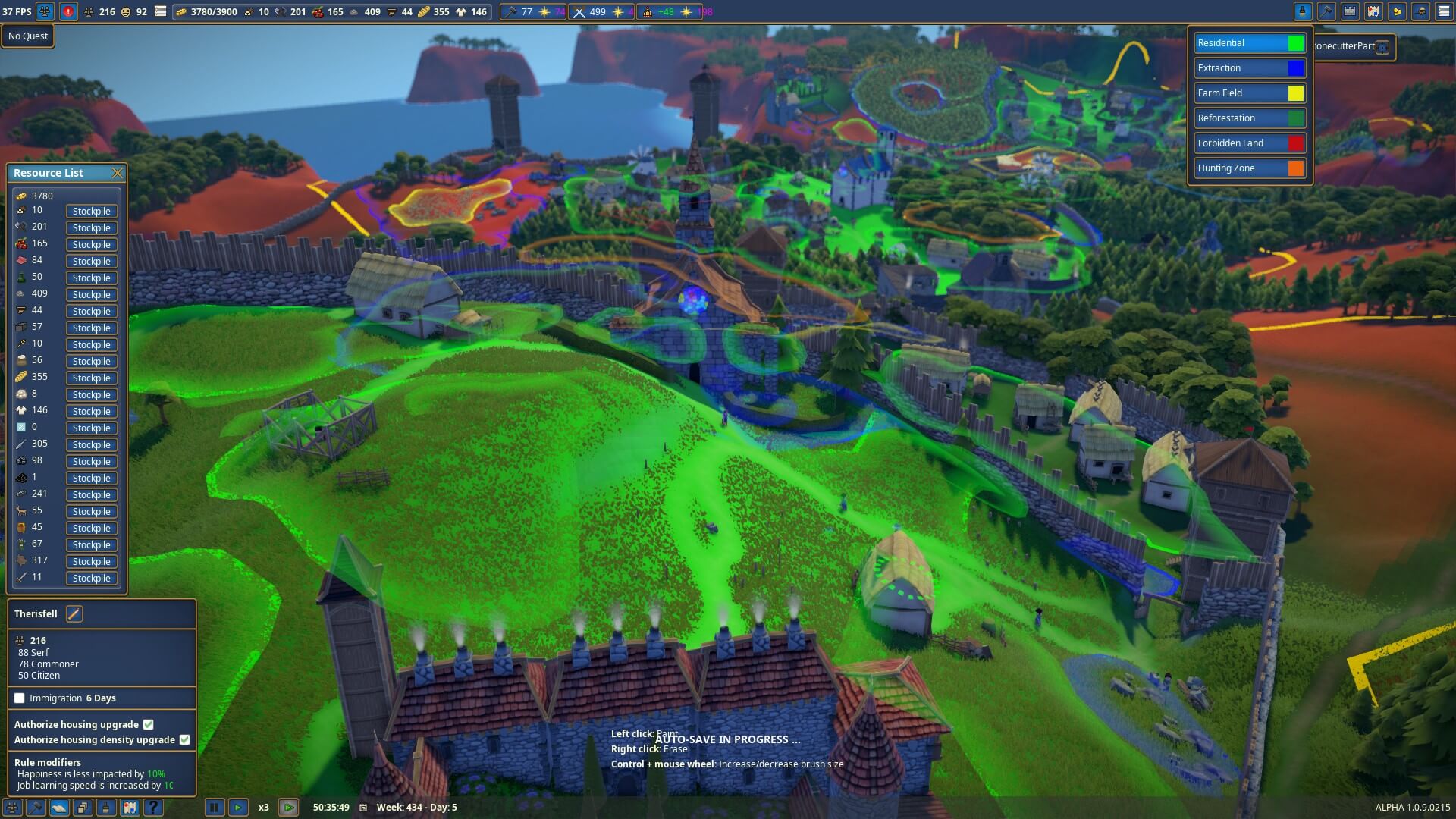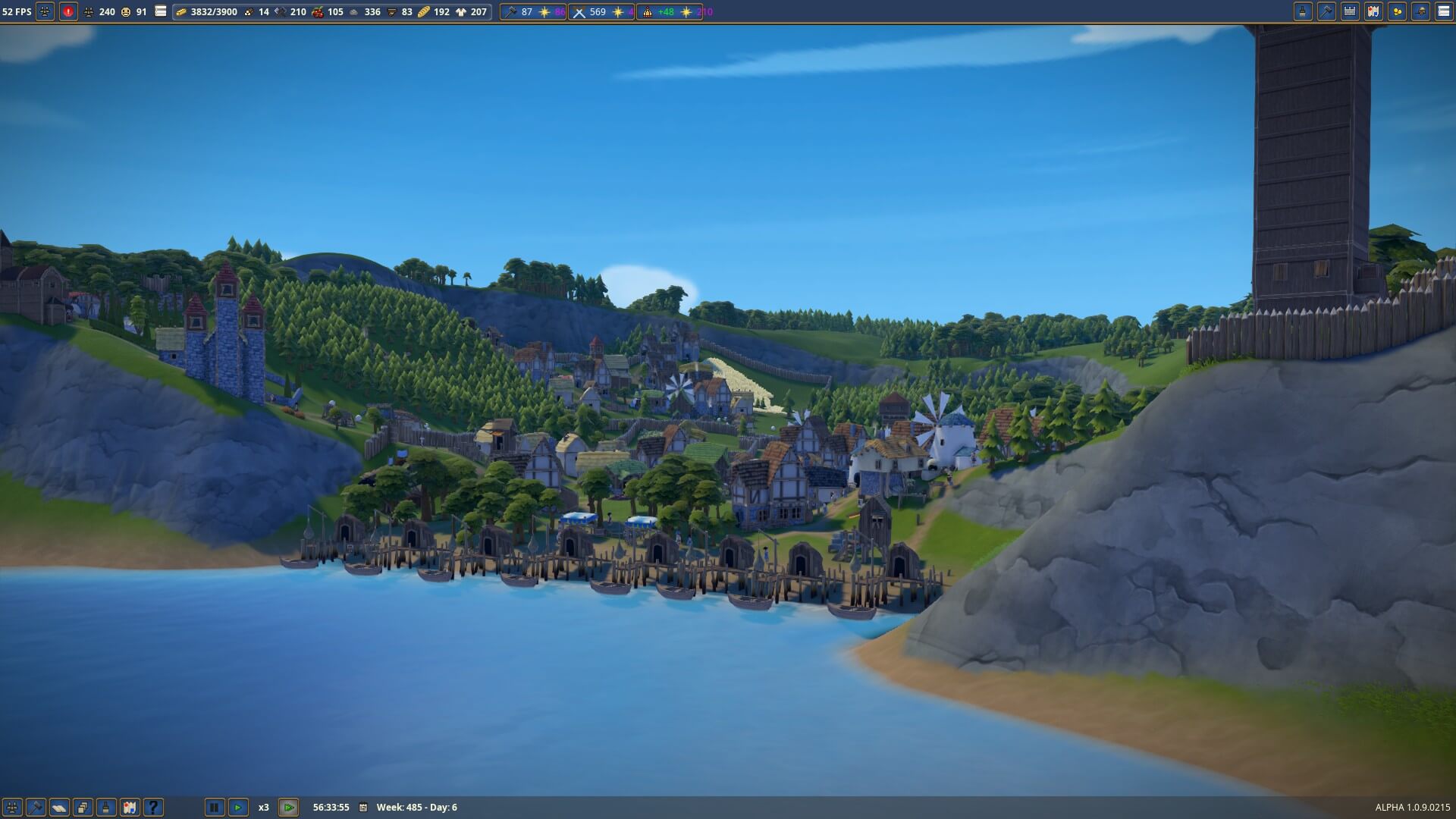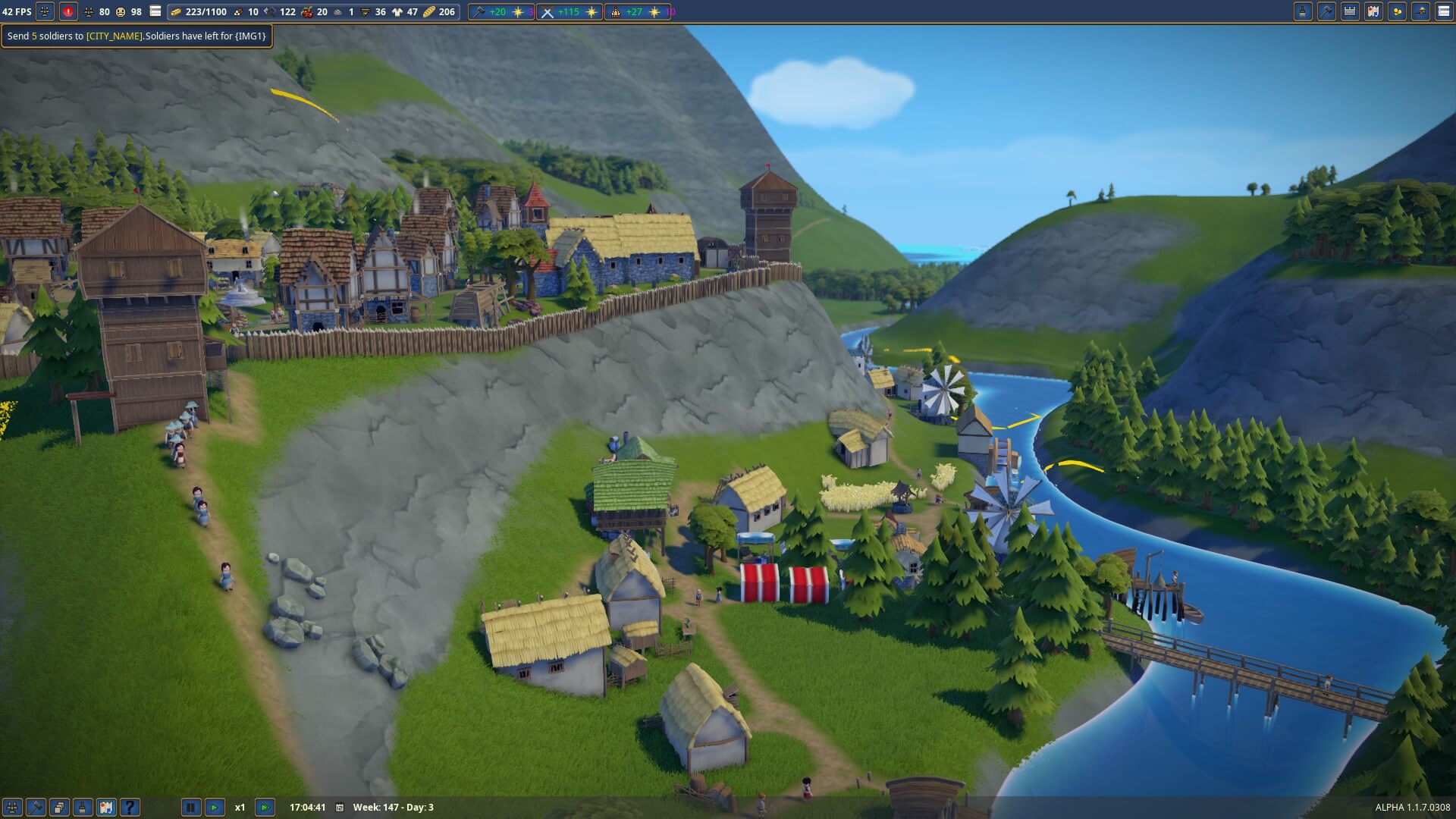Foundation — The picturesque, village-building beta
Sometimes, all I look for in a game is the fact that it looks pretty and is simple to play. So when I heard about Foundation, a non-grid-based, mediaeval city-building game from Polymorph Games, I was interested. When I peered with envy over my husband’s shoulder as he played the game, I had to try it out myself.
Foundation, which I first picked up in early access and is now in its alpha phase on Steam, is quite reminiscent of Banished in many respects. You begin with a limited number of citizens on an empty map of your terrain choice, with your task from there on out being to keep them alive, build and eventually prosper. But where Banished’s perspective was quite limited and its buildings confined to four rotations, Foundation gives rise to villages and towns that sprawl haphazard over hills and valleys — much as mediaeval towns did in reality.
https://www.youtube.com/watch?v=0O2osjKH8S0
Your first task, when the world loads in, is to choose a hex to start in and place your village centre there. It’s wise to pick a hex with food, stone and wood in or near it, and especially one without a river bisecting it, as you won’t have the resources to bridge the gap for quite some time — as I found out on my first playthrough. This hex system serves as your means of expansion through the game, spreading out from your home hex to claim new land and resources. Of course, the more land you have, the more tax you pay to the realm, so you don’t want to expand too fast. The rate of expansion we experienced seemed to be quite fair, although maybe a bit too easy with the free territory rewards later on.

While you build task-specific buildings — like wheat farms, markets and blacksmiths — and decorations manually, the beauty of Foundation is in its residential building system. Using the zoning tools, you specify the area where your villagers have the go-ahead to build and that’s it — where they build within that zone is entirely up to them. The result is a charming collection of houses huddled together for warmth, pushing as close to desirable areas as they can get. While this can sometimes lead to pathing errors (to be addressed in a later patch), the result is well worth it. If the area’s desirable enough, the houses there may upgrade, so you can watch your favourite little hamlet become a collection of fashionable townhouses as time goes on.
The zoning system also caters for resource gathering, resource sowing and disallowed areas. In terms of resources, a work building like a lumber camp is enough to let you assign workers, but they won’t do anything unless you tell them what to collect, and then they’ll only travel within a certain radius. This means that if you’re completely deforesting an area, you may need to move your lumber camp several times to get the lot. Thankfully, you can combine deforestation zones with reforestation zones to create a dedicated forestry space, although hunting zones and disallowed areas override anything else.
One of the most satisfying sights in Foundation is watching your villagers sow the fields of wheat you’ve planned out, watching it grow to its full height, then watching them cut it down for grain. It’s sometimes odd (because of the work radius) that farmers from one farm can seem to go over to work in another, but that fact doesn’t matter a great deal, other than cosmetically.

There is an issue with resource production at the moment: there never seems to be enough food later in the game, with fishing huts especially being quite slow. The current workaround for this is blocking the boats in with a disallowed zone so they come in and out really quickly with their full complement of fish. Hopefully this won’t need to be the case in future — either faster production or more job openings in the buildings themselves would be ideal — and it is on the developers’ list of balances to address.
The fruits of your labour are destined to either be gobbled up thus or stored away. Warehouses can give you some surplus storage on top of each building’s limit and also happen to be essential for trade — merchants travelling from other cities will only purchase goods from warehouses. Their interface (and that of the trading screen) aren’t the most intuitive out there, but they make sense once you get used to it. The prices and figures need a little adjustment, but it’s nothing that breaks the game.
Trade routes, once you unlock them, do form a good portion of your early income, but fade out later on in favour of your citizens’ spending on goods (they buy more expensive stuff as they climb the social ladder). So at the moment, trade feels a bit limiting — something which could easily be remedied by adding more trade routes (or randomly generating them), completing unfinished resource chains (and letting the products be sold) and general number fiddling.

One of Foundation’s best features is the ability to build custom buildings, to your own design. Choosing from a set of parts and colour schemes, you can piece together churches, keeps, monasteries, manors and markets. It works pretty well, with only some minor placement issues — markets in particular can get quite limited by placement radius if you intend to include a lot of stalls.
It’s great seeing your creations rise from the ground as your villagers set about building them and greater still to see an architectural progression as you unlock new components and buildings. By increasing your relations with the People, the Crown and the Clergy, you gain access to new parts relevant to the category. Periodic missions let you send resources to each for influence, so it pays to commit. Other, more generic, upgrades come naturally as your village, and your class of villager, grows.

Since we’ve mentioned keeps, it might be prudent to mention the obvious tag-alongs: soldiers. By assigning workers to either your keeps or your manors, you can get them to take up arms. This lets you send them off to battle every time an envoy comes to visit, which is a massively lucrative opportunity and worth jumping on as soon as it appears, even if you have to reassign some workers to those roles. There’s not much to it — it works the same as in Pharaoh where they vanish off the map for a while before returning with the loot — but it’s still a good feature, especially where it rewards free territory. The missions don’t scale with your village size, though, so it becomes easy quickly, and you never lose soldiers on missions. Again, though, this is a feature destined for future improvements.
That’s Foundation in its current state, and its roadmap, now accompanied by a Steam devlog, looks really promising. In terms of quality-of-life improvements, I think some more refinement to the camera movement, sheep farms providing at least some meat and a the inclusion of a repeating/expanded name list, possibly with surnames, wouldn’t go amiss. I’m also keen on the hinted idea of more animals (perhaps with merchants riding horses or donkeys) and would like to see more obvious distinctions in rank between villagers and, of course, more castle parts.

Now I have an admission to make: there was a hiatus between me writing this review during early access and realising the fickle mind of the internet had whisked the document away before it could be published. It was a perfect excuse to jump back into the alpha and update it. Did I need an excuse? No, not really. Foundation remains a beautiful game and a relaxing source of entertainment. Even as I write this, I have it open on the other screen, watching villagers meander down from the walled upper city of a fresh new village to the new outskirts being constructed by the river down below.
Foundation is an excellent early-access game that there’s already plenty of reason to sink time into. When it reaches full release, especially now that it supports mods, we expect it will be a surefire hit with fans of Banished, Pharaoh, Goblins of Elderstone and the like. Can’t wait until then? You can get it on Steam right now…
Foundation is available now in Steam Early Access for PC.
Comments are closed.